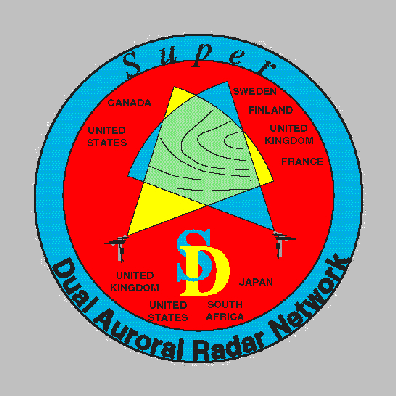|
ISTP |
>Misc Info |
>DARN |
Investigation: DARN Brief Description:
The Dual Auroral Radar Network (DARN) is one of the Ground-Based Instruments (GBI) of the ISTP/GGS project. The original DARN concept included both VHF radars and HF radars. This original concept, however, has been superseded by a network of HF-radars alone, which is now referred to as SuperDARN.

As it is currently configured, SuperDARN consists of 2 pairs of
radar systems in the northern hemisphere and a single radar in Antarctica.
The radar systems are coherent HF systems operating at frequencies
from 8 to 20 MHz. These radars observe the ionospheric plasma
drift velocities in both the E and F-Regions.
More detailed information about SuperDARN is available.
Each radar system is briefly described below (moving from East to West):
CURRENT OPERATING RADARS
Stokkseyri/Goose Bay Brief Description
The Stokkseyri/Goose Bay pair of radars are located in Stokkseyri, Iceland and Goose Bay, Labrador. Their common field of view includes a large portion of Greenland, particularly including the Sondre Stromfjord incoherent scatter radar. The Stokkseyri radar is operated by CNRS/LPCE and CNRS/CPET in France. The Goose Bay radar is operated by the Applied Physics Laboratory (JHU/APL).
Kapuskasing/Saskatoon Brief Description
The Kapuskasing/Saskatoon radar pair cover much of the central Canadian region. The radars are located in Kapuskasing, Ontario and Saskatoon, Saskatchewan. The Kapuskasing radar is operated by JHU/APL. The Saskatoon radar is operated by the University of Saskatchewan.
Halley Station Radar Brief Description
The Halley radar is located at Halley station, Antarctica. It is an HF radar virtually identical to the Goose Bay radar, and its field of view is magnetically conjugate to that of the Goose Bay radar. The Halley radar is operated by the British Antarctic Survey. The combined observations from Halley and Goose Bay form the Polar Anglo-American Conjugate Experiment (PACE).
BARS Brief Description
The Bistatic Auroral Radars System is one component of the Canadian CANOPUS system. It is a dual VHF radar system similar to STARE and observes plasma drift velocities in the E-region. Some Key Parameter data from the BARS radar are available, but the radar operations have now been terminated and the the plasma drift data from this geographic region are now obtained by the Kapuskasing/Saskatoon radar pair.
FUTURE RADARS
Hankasaalmi/Iceland West Brief Description
The Hankasaalmi/Iceland West pair of radars are expected to become operational in the summer of 1995. This pair of radars will be operated by the University of Leicester. The radars are located in Hankasaalmi, Finland and in Iceland (exact location TBD). The common field of view of this pair includes the EISCAT radar and the European Polar Cap Radar to be constructed on Svalbard.
Halley/Sanae/Syowa Brief Description
The Halley radar is currently operating and providing Key Parameters to the ISTP/GGS data base. In February of 1995 a second Antarctic radar is expected to become operational at the Japanese base, Syowa. A year later a third radar is expected to be completed at the South African research base, Sanae. This triple radar system will have a common field of view that includes South Pole (Scott/Amundsen base) as well as a variety of automated geophysical observatories (AGOs) operated by American and British scientists. The British AGO project is referred to as SESAME and is one of the Ground Based Instruments (GBI) of ISTP/GGS.
|
Webmaster:
N. Jaquith Privacy Statement | IT Security Warning | Accessibility Statement |
 |
